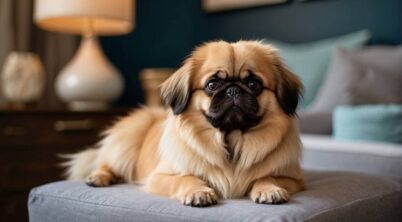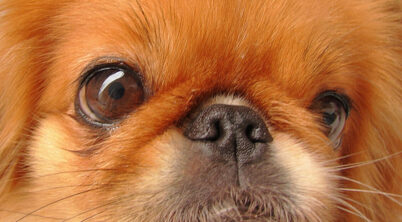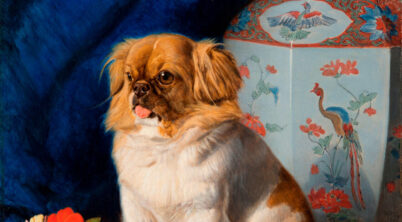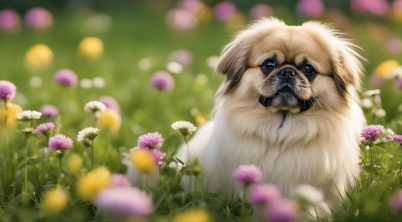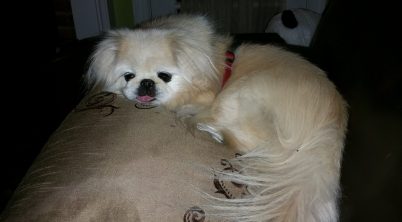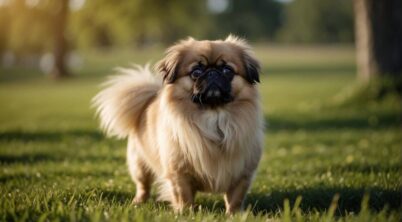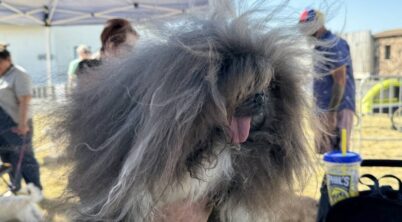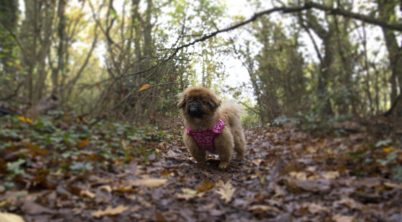Originating from the opulent palaces of Ancient China, the Pekingese breed is a living symbol of elegance and nobility. Held in high regard by the Imperial family, these dogs were once exclusive to Chinese royalty and were thought to encapsulate the spirit of the lion. With their bold and lion-like appearance, Pekingese puppies exhibit an air of dignity and self-esteem that belies their small size. As a toy breed, they are compact, with a characteristic pear-shaped body that features heavy forequarters and lighter hindquarters.
Pekingese newborn puppies, much like their adult counterparts, present with this distinctive morphology from the outset. Their thick double coat, which requires regular grooming, can come in various shades and monochrome hues as seen in the typical sable to the rare ice white. Despite their plush exterior and diminutive stature, these puppies exude a calm confidence and move with a dignified, unhurried gait. The nurturing of newborn Pekingese requires careful attention to ensure they grow into the poised and personable companions they are renowned for being.
Owners must pay close attention to the needs of these newborns, as their upbringing will shape the Pekingese’s characteristic confident comportment. As they grow, it’s essential that these puppies receive not only proper physical care, including nutrition and grooming, but also early socialization to maintain the poised yet affectionate temperament that the breed is known for. In doing so, Pekingese puppies are prepared to step into the legacy of their ancient lineage with the grace and poise worthy of their imperial heritage.
Table of Contents
Health and Care for Newborn Puppies
Proper health and care are paramount for newborn Pekingese puppies to ensure they develop into healthy adults. This section will address the immediate health assessment, optimal feeding and nutrition practices, and grooming necessities tailored to the needs of these puppies.
Initial Health Assessment
A newborn Pekingese puppy requires a timely health assessment to check for any signs of distress or congenital disabilities. This check might include ensuring that the puppy is breathing properly and is active immediately after birth. It is essential to observe the puppy’s behavior, looking for a calm but responsive state which indicates good health.
Feeding and Nutrition
Feeding: Puppies should be fed with a canine milk replacer that is warm—a temperature close to the mother’s body heat, around 100 degrees Fahrenheit. The Pekingese’s small mouth may require a suitable nipple size for feeding; sometimes, a human bottle nipple can be used if it allows for adequate milk flow.
- The bottle should be held at an angle to minimize air intake.
- Ensure the nipple hole is adequately sized, allowing milk to drip at one drop per second when lightly squeezed.
Nutrition: Comprehensive nutrition is crucial during the early life stage. Newborn puppies will feed every two to three hours on their mother’s milk or an appropriate substitute. By the fourth week, they can start transitioning to puppy food.
Grooming Needs for Puppies
Regular grooming is essential for Pekingese puppies not only to maintain their appearance but also to prevent irritation and discomfort due to their long fur and sensitive skin. Even as newborns, they should be gently brushed to get them accustomed to the process.
- Grooming should be initiated with a soft and suitable brush for their delicate fur.
- Focus on keeping the fur free of tangles and debris, which will also help in identifying any skin issues early on.
Pekingese Puppies Adoption and Purchase
When considering adding a Pekingese puppy to the family, one has the option of purchasing from a reputable breeder or adopting from a rescue. The cost of purchase and adoption can vary significantly, from a higher price when sourced from breeders to a more modest adoption fee that covers the pre-adoption care expenses.
Finding a Good Breeder
Pekingese Puppies for Sale: Prospective owners should prioritize finding a good breeder. A reputable breeder will have a deep understanding of the Pekingese breed and be able to discuss the puppy’s lineage, health, and temperament.
- Search: Utilize online platforms that connect dog lovers with responsible breeders to locate Pekingese puppies. When approaching breeders, verify their credentials and ensure they follow ethical breeding practices.
- Cost: Prices from breeders can range from $800 to $3,000, influenced by the puppy’s breeding quality. Breeders may also provide health guarantees and initial veterinary care documentation.
Adopting from a Rescue
Adoption: For those interested in a potentially less expensive alternative, adopting a Pekingese from a rescue is a commendable choice.
- Rescue: Adopting from recognized non-profit organizations, such as the Pekingese Rescue Network, supports the rehoming of dogs in need. Prospective owners are encouraged to consider rescue centers where adoption fees are generally around $300.
- Cost: This fee typically covers necessary expenses prior to adoption such as vaccinations, spaying/neutering, and other medical care the dog may have required.
Both purchasing from a good breeder and adopting from a rescue have their own processes and considerations. Individuals must assess their options and decide which route aligns with their values, budget, and the well-being of the Pekingese puppy they intend to bring into their home.
The Importance of Early Training
Early training for Pekingese puppies is crucial as it sets the foundation for their behavior and adjustment into adulthood. It is important to focus on their natural traits such as loyalty and confidence while also addressing any innate stubborn tendencies.
Socialization and Environmental Exposure
A Pekingese puppy’s development is heavily influenced by its early experiences. Socialization involves introducing the puppy to a variety of people, animals, environments, and sounds. This exposure helps foster a friendly and confident temperament, while mitigating fear or anxiety in new situations.
- People: Introduce to different individuals (children, adults, seniors)
- Animals: Safely expose to other vaccinated pets
- Environments: Familiarize with various indoor and outdoor settings
- Sounds: Acclimate to a range of noises (appliances, vehicles, crowds)
Obedience and Commands
Starting obedience training early helps establish clear communication and boundaries. This is essential for the Pekingese, whose natural loyalty can be coupled with stubbornness. Key commands such as sit, stay, and come should be taught using positive reinforcement.
- Key Commands:
- Sit: Encourages self-control and patience
- Stay: Builds confidence in stationary moments
- Come: Enhances the dog’s responsiveness and loyalty
It’s important to remain consistent and patient, rewarding good behavior with treats, praise, or play to reinforce obedience.
Exercise and Playtime
Proper exercise and playtime are essential for the development and well-being of Pekingese newborn puppies. They have specific needs, considering their energy levels and distinctive rolling gait influenced by their physical build.
Appropriate Exercise for Puppies
Pekingese puppies exhibit varying energy levels, and their exercise should align with their natural stamina and developing physical abilities. During their first few months, gentle exercise is paramount to protect their growing bodies. Structured play sessions that last 5 to 10 minutes, repeated several times a day, can sufficiently meet their exercise needs.
- Allow them to explore safely in a secured, puppy-proofed area.
- Short, frequent playtimes prevent overexertion and support joint health.
Playful Activities
Despite their regal appearance, Pekingese puppies can have a big personality and enjoy being playful. Their unique conformation, featuring a broad, flat head and a characteristically rolling gait, should guide the selection of appropriate activities.
- Introduce soft, chewable toys that encourage solo play and teething relief.
- Engage in light fetch games with small, soft balls that suit their size and energy.
By accommodating their playful spirit and physical limits, one ensures a Pekingese puppy’s growth is both joyful and health-conscious.
Grooming and Maintenance
Pekingese puppies necessitate careful grooming from an early age to maintain their distinctive lion-like mane and prevent their sturdy double coats from matting.
Coat Care
The Pekingese breed is adorned with a double coat consisting of a long, straight outer coat and a thick, soft undercoat. Starting grooming practices early acclimates puppies to the process, which involves:
- Weekly Brushing: Use a high-quality pin brush to gently work through the outer coat, reaching down to the undercoat. This removes loose fur and prevents tangles.
- Detangling: For any mats that do form, a stainless steel comb is effective in working them out gently.
- Bathing: Bathing should be infrequent to avoid stripping the coat’s natural oils. When necessary, use a mild puppy shampoo and ensure a thorough rinse.
Nail Trimming and Dental Care
Proper hygiene extends beyond coat maintenance, focusing also on nails and teeth:
- Nail Trimming: Regular nail trimming prevents overgrowth that could cause discomfort. Use a sharp nail clipper designed for small breeds and trim just the tips to avoid the quick.
- Dental Care: Begin dental hygiene early with a soft-bristled toothbrush and toothpaste formulated for dogs. This practice helps prevent plaque build-up and maintains overall health.
Lifestyle Considerations
When raising a Pekingese puppy, certain lifestyle considerations are vital for their well-being. The breed’s unique physical characteristics and temperament require a specific environment to thrive.
Home Environment
The Pekingese is affectionate and forms strong bonds with its family members, requiring an environment where they feel included as part of the daily household activities. They are also relatively calm, preferring a peaceful setting over a chaotic one. Given their small size at birth—weighing about 6 to 8 ounces—Pekingese puppies need a safe space where they cannot be easily injured by inadvertent steps or rough handling. Caution is necessary as their stubborn streak may sometimes make them less responsive to hazardous situations.
- Safety: Create a secure, puppy-proofed area free from hazards.
- Accessibility: Ensure they can easily access their designated eating and sleeping areas.
- Temperature: Maintain a comfortable room temperature as they are sensitive to heat due to their thick coat.
Compatibility with Other Pets
Pekingese puppies generally coexist well with canine companions, especially if introduced at a young age. However, due to their size and temperament, supervision around larger breeds is essential to prevent any accidental injury. When it comes to other types of pets, such as cats or rodents, early socialization is crucial.
- Socialization: Introduce the Pekingese puppy to other pets gradually and under controlled conditions.
- Observation: Always observe their interactions to ensure they are positive.
It’s important for owners to consider these factors to ensure their Pekingese puppy develops into a well-adjusted adult dog.
Pekingese Breed’s Legacy
The Pekingese breed carries a storied past steeped in ancient tradition and stands today as a reminder of its noble origins. The breed’s distinct lion-like appearance is a testament to its historical importance and enduring charm.
Historical Significance
The Pekingese has been a symbol of royalty and luxury within the Imperial Family of China for over two millennia. This breed, with its bold and lion-like appearance, was believed to ward off evil spirits. Revered by Chinese emperors, these dogs were so esteemed that theft of a Pekingese was once punishable by death. They made their journey to England in the 19th century as spoils of war, capturing the heart of Queen Victoria and quickly becoming a royal favorite there as well.
Modern Day Status
In the modern day, the Pekingese maintains its status as a cherished companion dog. Despite its small size, this breed exhibits a self-important demeanor and confidently holds to its legacy of imperial favor. As a toy breed recognized by various kennel clubs, the Pekingese continues to be a popular choice amongst dog enthusiasts who admire its unique blend of dignity and companionship.

